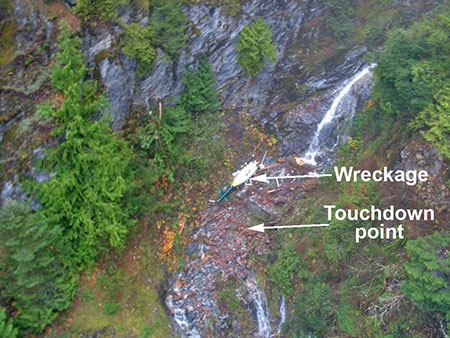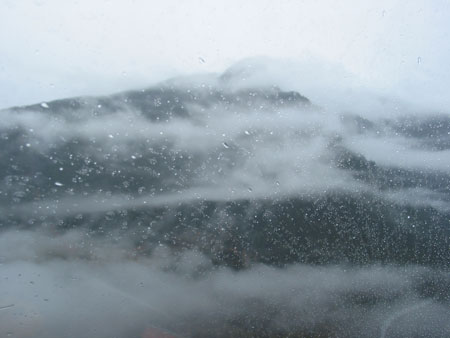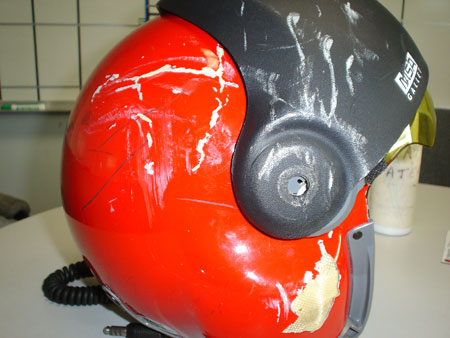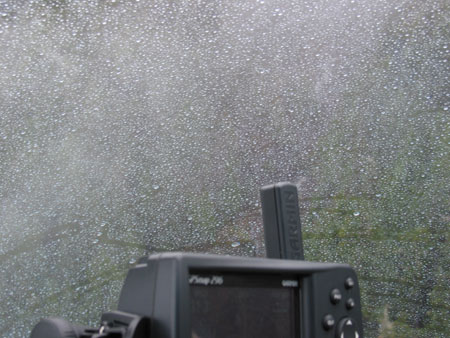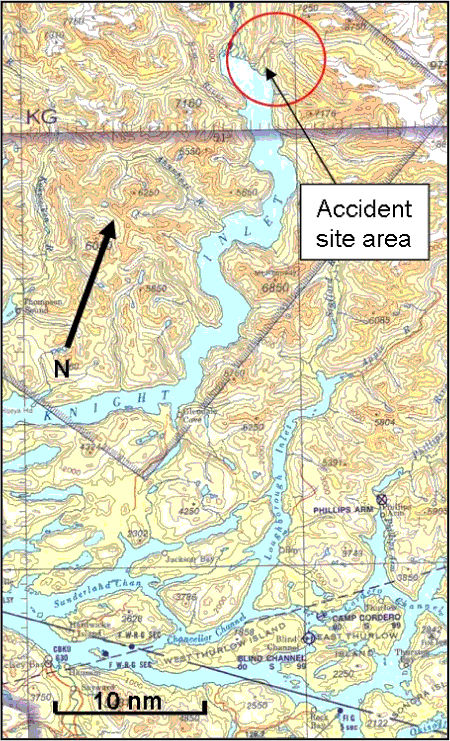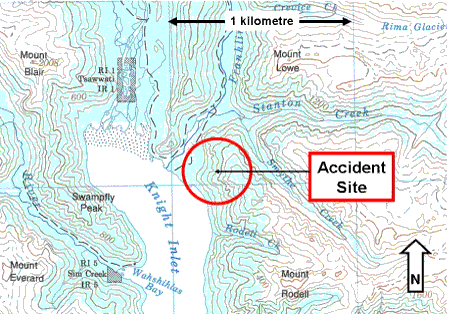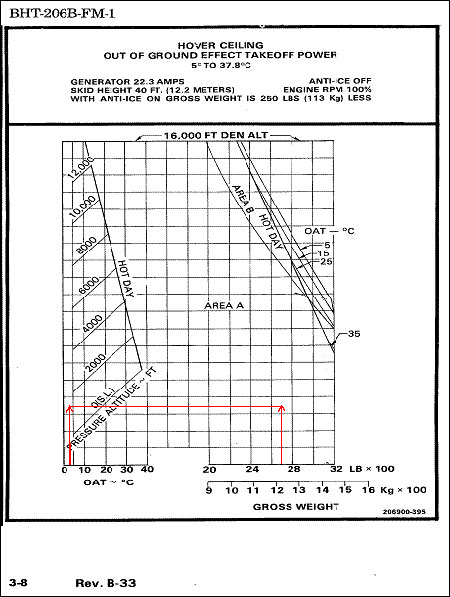Loss of Visual Reference - Collision with Terrain
VIH Helicopters Ltd.
Bell 206B (Helicopter) C-GWUF
Knight Inlet, British Columbia
The Transportation Safety Board of Canada (TSB) investigated this occurrence for the purpose of advancing transportation safety. It is not the function of the Board to assign fault or determine civil or criminal liability. This report is not created for use in the context of legal, disciplinary or other proceedings. See Ownership and use of content. Masculine pronouns and position titles may be used to signify all genders to comply with the Canadian Transportation Accident Investigation and Safety Board Act (S.C. 1989, c. 3).
Summary
At about 1700 Pacific daylight time, near the head of Knight Inlet, British Columbia, the VIH Helicopters Ltd. Bell 206B Jet Ranger helicopter (registration C-GWUF, serial number 1182), with only the pilot on board, touched down in a toe-in landing at an unprepared helicopter landing site in a steep, stream gorge. After the pilot had stabilized the helicopter with the toes of the skids in contact with the surface, one of the two waiting passengers entered the left front seat. The pilot then motioned the second passenger to enter the helicopter in the left rear seat.
As this passenger transferred his weight from the ground to the helicopter skid, the helicopter slipped backwards on the loose rock surface, and the pilot applied collective pitch and forward cyclic in an attempt to maintain the hover attitude. The pilot was unable to prevent the helicopter from turning quickly left, and he lost visual reference and control. The helicopter became airborne, struck trees adjacent to the landing site, rolled over, and came to rest on its left-hand side, almost inverted. Both passengers sustained minor injuries and the pilot sustained serious injuries.
The helicopter was substantially damaged; there was no post-impact fire. The accident site is located at 51°04′24″ N latitude and 125°32′37″ W longitude, at an elevation of about 1350 feet.
Factual information
History of the Flight
Earlier that day, after flying the two forest-harvesting engineers on a reconnaissance of the area, searching for potential pick-up sites, the helicopter pilot landed them at a drop-point on the ocean shoreline below the accident site. The engineers were evaluating the area for possible logging as they climbed up the steep gorge, eventually stopping at the site they had assessed as being suitable for helicopter pick-up. They then called the pilot to pick them up. The helicopter was parked at the base camp about two nautical miles (nm) away. The pilot took off for their location and searched for them while remaining in radio contact. Once the pilot located the passengers and the pick-up site, he assessed the site as suitable and flew to the touchdown zone they had prepared. The pilot had not previously landed at the landing site (see Appendix A).
The slope of the selected site required the pilot to conduct a toe-in landing using the hover-exit procedure. He lowered the helicopter in the hover, placed the toes of both skids on the surface, and stabilized the helicopter in that configuration. When the pilot indicated it was safe to do so, the first passenger climbed onto the left skid, opened the left front door, entered the cockpit, and strapped into the left seat using the full seat restraint. The helicopter remained in a stable toe-in position.
The pilot then motioned the second passenger to enter the helicopter. The passenger climbed onto the left skid and began to move aft; however, as he transferred his full weight onto the skid, the toes of the skids abruptly slipped downslope. The pilot instinctively applied collective lever, forward cyclic and right pedal to counter the sudden movement, but at this time, the pilot was unable to see out through the windshields because of increasing condensation on the inside surfaces and the rain and mist on the outside. He lost all visual reference with the terrain. The helicopter became airborne, with the second passenger now clinging to the left skid. Almost immediately, the passenger released his grip and dropped to the (surface) ground. The helicopter, now turning and rolling to the right, struck trees with the rotor blades and crashed onto the rock ledge about 10 feet ahead of the pick-up point.
After the helicopter came to rest, the engine continued to run. Even though there was some smoke initially in the cabin, no fire erupted. The passenger in the left seat turned off the fuel valve and closed the throttle to shut down the engine. The two passengers then removed the pilot from the wreckage, administered appropriate first aid to the pilot and themselves, and set up a camp to await rescue. Both passengers were trained first-aid attendants and were skilled in survival in the forest. Through a combination of satellite telephones and hand-held radios, the passengers communicated with several agencies to advise them of their accident, and they remained in good communication throughout the evening. One of the passengers retrieved the emergency locator transmitter (ELT) from the wreckage and activated it manually.
Search and Rescue
Following the occurrence, at about 1700 Pacific daylight time,Footnote 1 the passengers established communication with the base camp and the operator to advise them of the accident. Canadian Department of National Defence Search and Rescue was promptly alerted and rescue efforts were set in place within 30 minutes of the accident. Tasked by the Joint Rescue Coordination Centre in Victoria, British Columbia, search and rescue (SAR) aircraft from 19 Wing Comox flew to the area to search for the survivors. Their efforts were hampered by nightfall and poor weather conditions. Toward midnight, a break in the fog cover enabled rescuers in a Cormorant helicopter to find the pilot and passengers and winch them on board. They were transported to hospital at Comox, British Columbia.
Landing Area
The landing site was a terraced ledge, about 40 feet wide, in a steep gorge on the west face of the mountain, and adjacent to a rapidly flowing waterfall. The site was surrounded by tall trees and almost-vertical rock faces, and the landing surface consisted mainly of loose rock and forest debris, constantly wet from the waterfall flow. The distance from the touchdown point to the waterfall rock face was about 50 feet, and the helicopter ended up about 20 feet away from the waterfall (see Photo 1).
The landing site is located at 1350 feet above sea level. The temperature was not formally recorded at the site, but was in the order of 5°C. Given such values, the density altitude would have been about 300 feet.
Weather
The weather at the time of the accident was reportedly not conducive to sustained visual flight because it was raining heavily and there was widespread, layered fog in the whole mountainside area. Nonetheless, the specific flight path chosen by the pilot was navigable with visual reference to the ground, and the landing site was discernable. The winds were shifting in strength and direction, at speeds estimated up to 15 knots. In general, the prevailing winds at the accident site would have been erratic at that time of the evening, and there was a possibility of downflowing air.
The weather conditions on the following day were reported by site personnel as quite similar to the day of the accident, and Photo 2 shows the weather conditions likely faced by the accident pilot.
Pilot
The pilot was certified and qualified for the flight in accordance with existing regulations. He held a valid Canadian commercial pilot licence - helicopter and had accumulated about 1450 total flying hours, of which 350 hours were on Bell 206 helicopters. He had worked for VIH Helicopters Ltd. as a line pilot for about six months and met all company recurrent ground and flight-training requirements. Both his initial and recent flight training in mountain operations with VIH Helicopters Ltd. had been extensive, and he knew of the conditions that characterize unprepared landing sites in mountainous regions.
The pilot was appropriately rested before commencing duty on the day of the accident. The Knight Inlet operation had started on 23 October 2006, two days before the accident, and the pilot had flown about four hours for the project. He was characterized by clients and peers as being a competent and cautious pilot.
Helicopter Information
The accident helicopter is a Bell 206B-II Jet Ranger, manufactured in 1973 by the Bell Helicopter Company in Texas, United States, as serial number 1182. The investigation team was unable to gain access to the accident site because of the inhospitable terrain, and the wreckage was initially examined from the air to the degree possible. Later, the helicopter was removed from the ledge by a professional salvage team, and subsequently examined by investigators in a secured facility at Campbell River, British Columbia. There was no indication of any pre-accident anomaly or malfunction with the flight controls, the drive train, or any other system that could have contributed to the accident circumstances. The maintenance logs and records indicated that the helicopter was certified, equipped, and maintained in accordance with existing Canadian regulations and approved procedures.
Engine Information
The engine installed in the accident helicopter was a Rolls Royce (formerly Allison) gas turbine 250-C20 model engine, serial number CAE-820707, which is rated at 400 shaft horsepower (shp). Engine maintenance logs record that the engine was maintained in accordance with existing Canadian regulations and approved procedures. In consideration of the reported sequence of events, the investigation ruled out both engine mechanical malfunction and loss of performance.
The engine manufacturer's development of the 250-C20 series engine has led to a more powerful and reliable model, the 250-C20B, developing 420 shp, which in helicopter applications, provides greater power available to the main rotor gearbox. Allison/Rolls Royce has implemented an engine upgrade program that converts the 250-C20 to the higher-performance C20B model.
Incorporation of the following items forms the largest part of the conversion process (reference: Allison Commercial Engine Bulletin CEB-1053 17 November 1975 with revisions):
- C20B compressor and turbine modules;
- modified engine accessory gearbox;
- modified engine fuel control system;
- new associated engine data plates; and
- improved cockpit engine monitoring gauges.
The C20 engine compressor and turbine modules are no longer available from the manufacturer, and C20B modules are being used as airworthy replacements during C20 engine repair and overhaul. According to Rolls Royce, such replacement is an approved practice. The incorporation of the C20B modules alone does not upgrade the C20 engine, and although engine efficiency and performance is increased with the C20B components, the engine must continue to be operated at the original certificated specification limits. Such was the case with the Rolls Royce 250-C20 installed in C-GWUF, as only the compressor and turbine sections were C20B components.
Bell 206B Type Certificate
The Bell 206B-II helicopter was originally type-certificated in the United States with the Allison (now Rolls Royce) 250-C20 model turbine engine only. The upgraded Bell 206B-III helicopter uses the higher-performance Rolls Royce 250-C20B engine. By design, the main rotor transmission in both these helicopters is limited to a maximum of 317 shp from the engine, and consequently the engines are de-rated to meet this limitation.
The type certificate for all versions of the Bell 206 helicopter is now held in Canada by Bell Helicopter Textron Canada Limited of Mirabel, Quebec. Because the 250-C20B model engine is not on the approved type certificate for the Bell 206B-II, it cannot be installed in that helicopter. Nonetheless, replacement 250-C20 engines with the C20B modules are being installed in this model helicopter as an approved practice. Although the engine continues to be operated at C20 limits, the increased engine performance essentially permits maximum performance for the Bell 206B-II at higher-density altitudes. Consequently, even though the theoretical specification power difference between the two engine models is 20 shp, in practical terms, given this hybrid C20 engine, the available power differential would be significantly less.
Cabin Heating System in C-GWUF
The cabin heating system in the accident helicopter was installed as approved supplemental type certificate (STC) SH3887NM by Air Comm Corporation of Boulder, Colorado, United States, dated 24 December 1987 with revisions. This installation forms part of the Bell 206 Transport Canada-approved rotorcraft flight manual (RFM) as flight manual supplement (FMS) 206H-200, which applies to Bell 206A and 206B model helicopters only.
The heater is a bleed-air type that uses bleed air from the engine compressor section and mixes it with cabin air to provide heat for the occupants and for the windshield defrosting vents. In C-GWUF, the original defog blower fan could also be used to circulate heated air through the defroster vents.
No operational restrictions exist when the heater is installed in a Bell 206 with a Rolls Royce 250-C20B engine. However, the 250-C20 engine has limitations because the original STC program only validated the C20B engine. According to the normal operating procedures in the Air Comm Corporation heater FMS, the heater and defroster control is to be selected off before take-off, and during hover, descent, and landing. The supplement also warns that "Flight with heater and defroster operating is prohibited during take-off, hover and landing for aircraft equipped with the C-20 engine."
Accordingly, for the case of the C20 engine only, the heater and defroster must be selected off during take-off, hover, and landing. For the C20B engine, the performance degradation with the heater on is relatively small, and by way of example, for flight conditions similar to the day of the accident, there would have been no noticeable effect on either engine power or hover performance. The effect on the C20 engine has not been quantified directly, but since the maximum specification power output is only 20 shp less than the C20B model, it is likely that the performance effect is similarly slight.
Nonetheless, the limitation does exist, and the accident pilot complied with the operating instructions in the approved RFM. In the final stage of the approach to the landing site, the pilot turned the heater and defroster off and kept the defog vent blower fan running.
There is no Canadian requirement for a heater to be fitted to a helicopter. Although Canadian Aviation Regulations (CARs) are silent on the requirement for a heater in an aircraft, they do prescribe that the windshield be able to be demisted. In the Canadian weather environment, a heater is necessary for effective windshield demisting/defogging.
Helicopter Weight and Balance
Shortly before take-off on the accident flight, the pilot filled the fuel tank with Jet A-1 fuel to a fuel quantity gauge indication of about 50 US gallons. This amount equates to about 340 pounds of fuel, which was more than adequate for the proposed mission. The helicopter flew for about 10 minutes before the accident.
TSB investigators calculated that the gross weight of the helicopter at the time of the accident was no more than 2550 pounds (one passenger aboard); had the helicopter taken off with the second passenger on board, the weight would have been in the order of 2700 pounds. With reference to the Bell 206B helicopter RFM, the maximum gross take-off weight is 3350 pounds (internal load).Footnote 2 The calculations also indicated that both the longitudinal and lateral centres of gravity (CG) were within certified limits.Footnote 3 The lateral CG, however, moved close to its left limit when the second passenger transferred his weight onto the left skid; the lateral CG quickly returned to the centre when that passenger dropped off the skid.
Hover Performance
The hover-out-of-ground-effect (HOGE) hover ceiling chart in the Bell 206B RFM provides maximum allowable gross weight for varying conditions of pressure altitude and outside air temperature to ensure that the helicopter can hover without the performance benefit of ground effect. For the conditions at the time of the accident, the HOGE chart showed that the weight of the helicopter with the three occupants on board would have been well within the out-of-ground-effect performance capability of the helicopter (see Appendix B).
Hover Exit (Toe-in Landing) Procedure
Toe-in landings are normally used where the slope of the landing area exceeds the prescribed off-level landing limits of the helicopter. The toe-in landing procedure permits the drop-off or pick-up of passengers or cargo by the pilot touching the helicopter down on just the forward portion (the toes) of the skids. Passenger and cargo movement then takes place while the helicopter is balanced on the toes. This requires the pilot to set a high collective position to maintain a significant amount of power—within about 15 per cent of hover power—to prevent the helicopter from rotating tail-down about the ground contact point (the toes). The toe-in landing and passenger pick-up or drop-off procedures are finely balanced manoeuvres, requiring the pilot to smoothly and constantly adjust collective pitch and cyclic stick position as each passenger boards or disembarks the helicopter.
The practice of the toe-in pick-up is not without risk, but when carried out in a controlled and cautious manner, the procedure is practical and is an accepted technique throughout the helicopter industry. During toe-in landings, there is the potential of significant longitudinal and lateral CG shift during passenger and cargo operations. For this reason, all movements are cautious and slow to allow the pilot to progressively feel the helicopter's response to the changing loads. In the event of a sudden weight change, however, the helicopter's response may be rapid and greater than the pilot had anticipated, thus leading to larger fuselage movements and subsequently larger flight control movements (that is, pilot inputs) to counter those movements. It is also possible that the pilot could lose visual and tactile contact with the surface and unintentionally become airborne.
Section 4, Annex B (Hover Exit Operations), of the Transport Canada-approved VIH Helicopters Ltd. company operations manual identifies the risks of entering or leaving a helicopter in hover flight and provides instruction and procedures for pilots to carry out these operations. A review of the specific operational practices carried out at Knight Inlet revealed no deviation from these instructions.
Crashworthiness/Survivability
The injuries to the passenger in the left front seat and the pilot were caused by impact forces when the helicopter rolled over and struck the terrain. The passenger outside the helicopter received minor injuries when he dropped from the skid before the helicopter crashed. Medical information and injury patterns indicate that the pilot and passenger in the cockpit were wearing full seat restraints, and the pilot was wearing a flight helmet (see Photo 3). Both these factors contributed to their survival of the impact and the lessening of their injuries.
Loss of Visual Reference
It is a known characteristic that the interior surfaces of plexiglass in a Bell 206 cabin, particularly the windshields, are susceptible to fogging in high-humidity conditions, thus degrading a pilot's ability to see clearly. To counter this problem, a defog vent blower fan is installed in the cockpit and, coupled with the aircraft heater, provides a recirculating airflow to reduce the fogging of the windshield and side windows. There is no opportunity for the pilot to manually wipe the surfaces to clear the moisture away from the windshield in the hover since the pilot needs both hands to safely manoeuvre the helicopter.
An additional restriction to vision for a Bell 206 pilot occurs in rain because the helicopter is not equipped with windshield wipers. When the helicopter is in forward flight, rain on the windshield runs off with a small amount of beading. However, at low forward speeds, and particularly in the hover, the airflow over the windshield is reduced and water can accumulate and cause significant restriction to visibility. Photo 4 shows the forward visibility from a Bell 206 cockpit at low forward speed in moderate rain.
It is also a frequent event that, when a person in wet clothing with rain enters the cockpit, the windshields quickly fog up, even with the vent blower operating. Normally, this is a temporary condition and the condensation is quickly reduced or removed. However, there are circumstances when the humidity is so high that the fogging does not dissipate sufficiently and the pilot experiences a prolonged period of marginal visibility through the windshield.
Visual Illusion
One of the phenomena that leads to visual illusions in hovering flight occurs when the surface of a body of water ripples or moves, as a result of rotor downwash for example, giving the helicopter pilot a strong perception that the helicopter is moving even though it is actually stationary. A similar effect can be seen with rapidly falling water, such as a waterfall, where the pilot is influenced by the rapid water movement and can lose hover reference. Additionally, beaded water droplets moving across the windshields can introduce a sensation of movement. Yet, another phenomenon in hovering flight happens when the main rotor blades pass through saturated air causing downwash condensation trails that may, in an already reduced visibility situation, lead to a visual illusion of motion.
Furthermore, in certain lighting conditions, the curvature of the windshield is conducive to reflection of shiny or bright objects in the cockpit, and such reflections can interfere with a pilot's depth perception, particularly with rain and condensation on the windshields.
Pre-flight Safety Briefings
In accordance with both VIH Helicopters Ltd. and the contracting company's policies, on the morning of Monday, 23 October 2006, the pilot and the lead engineer conducted thorough safety briefings for all personnel involved in the Knight Inlet operation before the job began.
The briefings were comprehensive and comprised review and discussion of all appropriate operational procedures, such as toe-in landings, boarding techniques, and protocols for emergency procedures and communication.
Analysis
There was no indication of any pre-accident flight control or rotor drive system malfunction on the helicopter that would have contributed to a loss of control. Therefore, this analysis will focus on the flight performance available from the helicopter, the environmental conditions, and the effects of the Air Comm Corporation heater operating limitations.
Helicopter Performance
Ample engine (and transmission) power was available to hover out of ground effect. From a vertical performance perspective, this is the hardest condition to satisfy. Therefore, the helicopter aerodynamic performance did not contribute to the circumstances of this accident.
Operating Environment
Several conditions combined to present the pilot with a greater-than-usual challenge on this landing and pick-up task, as follows:
- there were layered bands of fog in the area;
- it was raining and the air was saturated;
- the terrain was steep and the gorge narrow;
- the touchdown zone was confined with little room to manoeuvre;
- the landing surface was remarkably off-level and consisted of loose rock and debris;
- the surface required a hover exit (toe-in) procedure;
- the wind was moderate and continually shifting, likely with a downflowing component;
- the waterfall adjacent to the site was flowing rapidly; and
- the RFM required the cabin heater to be turned off.
As a result of the rain, the temperature, and the terrain, the air was saturated and conducive to rapidly changing zones of reduced visibility. On its own, this environment would have made it difficult for the pilot to maintain visual reference with the terrain. Add to this the suspension of effective windshield demisting and the entry of the wet passenger, cockpit visibility would have progressively deteriorated.
The toe-in landing procedure did not allow the pilot any opportunity to pause and clear the windshield and windows before continuing flight. The helicopter was already in hover flight, requiring the continuous manipulation of the flight controls. Once the helicopter touched down under these circumstances, the pilot would experience restricted external visibility and hover reference.
The pilot found the selected site and touched down without event. The helicopter was then in a stable toe-in hover condition where the pilot had a small area to use as a hover reference. However, shortly after the first passenger entered the cockpit, the windshield began to fog heavily, despite the vent blower fan operating, and the pilot found it increasingly difficult to see out. Once the second passenger climbed onto the left skid and the helicopter slipped rearwards, necessitating corrective flight control inputs, the pilot had insufficient exterior vision and he lost hover reference. Exacerbating this condition was the rapid waterfall in the pilot's peripheral vision, leading to vision illusion and disorientation. This condition rapidly degenerated into a loss of control and led to the rollover and heavy impact with the terrain.
Centre of Gravity Shift
In this accident, the sudden loss of the passenger from the left skid would have exacerbated the already challenging task for the pilot of countering this weight on the skid in a deteriorating visual climate. After the helicopter broke contact with the surface, the pilot's sole tactile reference point was lost, and without clear vision, he was unable to maintain visual hover reference with the terrain.
Air Comm Corporation Heater
The heater and demister system installed in this helicopter was effective in controlling the interior condensation, allowing the pilot clear vision through the windshield and side windows. However, once the heater was turned off to comply with the RFM limitation, the remaining defog blower was incapable of keeping the windshield and windows clear; the condensation worsened and the pilot's visibility progressively deteriorated.
Flight Manual Limitations
The RFM restrictions to turn off the heater during take-off, hover, and landing apply only to Bell 206 helicopters equipped with the Rolls Royce 250-C20 engine. The genesis for this limitation rises from the certification process employed by Air Comm Corporation during the development of its STC for the heater, which only tested the performance of the higher-powered 250-C20B engine. The difference between the maximum specification power output of the C20 and the C20B models is 20 shp. However, since C20 components are no longer available and C20B components are being installed at engine overhaul, the C20 hybrid engine produces more than its rated 400 shp. This bonus performance is purposely not utilized because the engine limitations remain the same, and the main transmission input limitation of 317 shp continues to apply. Regardless, this increased engine power is realized indirectly by virtue of the higher-density altitudes at which specification power continues to be available.
With respect to the operation of the heater and the 250-C20 engine, it is possible that the actual decrease in engine output poses no impact on the performance of the helicopter compared to a helicopter equipped with the C20B engine, except at high-density altitudes.
The heater function restriction contained in the RFM appears to be an unnecessary operational constraint on Bell 206 helicopters with the C20 engine. The risk continues that pilots will face the frequent dilemma of choosing between the following:
- complying verbatim with the RFM limitations and experiencing poor visibility resulting from inadequately controlled windshield condensation; or
- maintaining satisfactory external hover reference at the expense of non-compliance with the RFM.
While it is recognized that some environmental circumstances may occasionally require the heater limitation to be followed, operating without the heater presents a greater risk in some cases. Presently, there is no relief from the RFM limitation for Canadian operators of the Bell 206 that would allow a pilot to assess each individual operational situation and select the heater and demister as appropriate.
Survival
The full seat restraints, as well as the pilot's flight helmet, helped prevent more serious injuries. The formal review at the start of the operations at Knight Inlet regarding the hover exit procedures, emergency procedures, and local communication practices was thorough and effective. The quick reaction by the front seat passenger in securing the engine, fuel, and electrical services likely prevented a post-crash fire. This review also certainly benefited the notification and response of SAR forces, leading to the timely location and recovery of the survivors.
Both of the passengers were trained in first-aid procedures and forest survival techniques, which were significant positive factors in preventing the pilot's condition from deteriorating and in establishing a stable and safe shelter for them all.
Findings
Findings as to causes and contributing factors
- The selected touchdown area was significantly sloped and the surface consisted of loose rock and debris, which allowed the skids to slip rearwards when the rear passenger climbed onto the left skid.
- Saturated air, low temperature, rain, and mist from the waterfall caused significant water droplet accumulation on the outside surfaces of the helicopter windshields, impairing the ability of the pilot to maintain visual reference.
- The air in the cockpit quickly became saturated when the first passenger entered the cockpit, causing the rapid formation of heavy condensation on the inside surfaces of the helicopter windshields and front door windows.
- The operational restriction in the flight manual supplement to turn off the heater removed the most effective means of preventing condensation accumulation on the inside of the windshields; this affected the pilot's external visibility and caused him to lose hover reference.
- With no visual external references to maintain the hover position, the pilot was unable to control the helicopter when it slipped rearwards, and it struck the terrain and rolled over.
Finding as to Risk
- The heater function restriction contained in the rotorcraft flight manual is an unnecessary operational constraint on Bell 206 helicopters with the C20 engine, and the risk continues that windshield condensation will adversely affect a pilot's ability to clearly see outside the helicopter.
Other findings
- Given the minor difference of power output between the 400-shp C20 and the 420-shp C20B engines today, it is possible that the actual decrement in engine output resulting from heater operation poses no impact on the performance of the helicopter, except at high-density altitudes.
- The pilot's helmet and seat restraints and the front passenger seat restraints prevented more serious injury to the pilot and passenger.
- The formal review at the start of the operations at Knight Inlet benefited the notification and response of search and rescue forces, leading to the timely location and recovery of the survivors.
- The front seat passenger's quick cockpit reactions to secure the helicopter likely prevented post-impact fire.
- Both passengers effectively used their training in first aid and forest survival, which prevented the pilot's condition from deteriorating.
This report concludes the Transportation Safety Board's investigation into this occurrence. Consequently, the Board authorized the release of this report on 11 February 2008.
